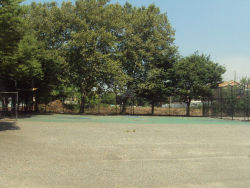Bergen Beach Playground
Bergen Beach Playground
Bergen Beach Playground is built on fill that joined the ancient island of Winnipague to the mainland in 1918. Abounding in game and fish, the island was used seasonally by the Canarsie, a Leni-Lenape tribe of the Algonquian peoples that once occupied much of eastern North America.
The Dutch West India Company set up a trading post near here in the early 17th century. The newcomers were especially interested in wampum, tubular beads drilled from mollusk shells and used as currency in the beaver pelt trade. By the 1640s, Winnipague was one of the leading sources of wampum on Long Island, fueling a mercantile system that extended from the Adirondacks to Europe and Russia.
The namesake of Bergen Beach, Hans Hansen Bergen, was an immigrant shipwright from Norway and the first European to own what was then known as Meutelaer's (or Mentelaer's) Island. The Bergen Homestead was built by Thomas Spicer in 1656 and stood about two blocks south of here, at East 72nd Street and Avenue V. British officers occupied the island and used the house as an outpost before the Battle of Brooklyn.
Far from the city, Bergen Island was a remote, rural place well into the 19th century. An 1888 description from the Brooklyn Eagle captures its pastoral beauty: "The road, after crossing the bridge, led into a thick forest. It looked as if it had been undisturbed for centuries. The trees completely shaded the road, so that we seemed to be riding through a leafy bower."
By 1893, however, the future had arrived. That year, developers Percy Williams and Thomas Adams Jr.—one of the inventors of chewing gum—opened an amusement resort on the island. Among its attractions were a casino, roller-skating rink, boardwalk and vaudeville theater. Though popular, the resort was bedeviled by fires and its great distance from downtown Brooklyn and Manhattan. It closed in 1918—the same year Bergen Island was joined to the mainland.
Not long after this, a group of Manhattan developers attempted to build on the site a residential community with bathing beach, pavilion and new amusement park. The plan never reached fruition, and the land was sold off piecemeal for development. The Bergen Homestead, one of the oldest buildings in New York State, was tragically lost to fire in 1934. Remnants of the old boardwalk and resort pavilions were removed five years later. Well into the 1950s, Bergen Beach remained the largest undeveloped area in Brooklyn; some blocks—including those just north and west of the playground—were not built up until the late 1990s.
Located on East 71 Street between Avenue N and Avenue T, the site opened to the public as a jointly operated playground with the Board of Education (now the Department of Education) on December 16, 1970. Formerly known as J.H.S. 312 Playground, Parks Commissioner Henry Stern renamed it Bergen Beach Playground in 1985 in reference to the surrounding community.
Bergen Beach Playground was renovated in 2018 through the Community Parks Initiative – a multi-faceted program to increase the accessibility and quality of parks throughout the five boroughs in an equitable manner. The park received updated basketball courts, play equipment, spray showers, a synthetic turf field, as well as adult fitness equipment and new plantings.
Check out your park's Vital Signs
Clean & Safe
Green & Resilient
Empowered & Engaged Users
Share your feedback or learn more about how this park is part of a
Vital Park System



